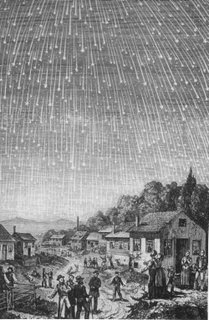
Extraterrestrials and global warming.
The Leonid meteor display occurs between 15 and 21 November each year, with peak activity on the night of the 17/18 November. The observed meteors are produced by the collision with the Earth's atmosphere of small dust particles ejected from the parent comet, Tempel-Tuttle. This object moves around the Sun in an elliptical orbit with a period of revolution approximately 33 years. The dynamical features of the orbit are similar to those of Halley's comet, and so comet Tempel-Tuttle is classified as a Halley-type short-period comet. Owing to the extreme inclination of the cometary orbit (162 degrees), the dust grains collide almost head-on with the Earth, at a relative velocity of about 71 kilometres per second. At such a speed, a centimetre-size particle has the same kinetic energy as a speeding truck on a motorway.
The faintest meteor that becomes visible to the average viewer on Earth is typically about 0.6 millimeters across (less than one-tenth of an inch or about the size of a sand grain). While such a speck is here and gone in a flash, the energy involved could light a 100-watt light bulb for about 2.5 seconds.
A slightly larger meteor, just 1 millimeter across and only moderately bright, packs the punch of a .22 caliber bullet.
Spectacularly bright fireballs, for which this annual event is known, dissipate far more energy during their plunge through the atmosphere. A typical fireball, which can briefly shine as bright as the planet Venus, is the size of a marble, about 9 millimeters in diameter. This has the energy release of 1 million joules.
A Leonid crashes into Earths upper atmosphere at more than 71 kilometers per second. A typical bullet from a rifle, moving at what seems like blinding speed, creeps along by comparison at just 1,000 meters per second.
The comet grains become visible at around 100 kilometers because they heat up as they plow through air, to the point that they glow. Most of them disintegrate high overhead.
Most of the mass will come from big fireballs, because if you put 10,000 typical small Leonids together, they would weigh just 0.1 grams. A bright fireball, however, can weigh as much as 85 grams.During the course of the peak hour over North America in the pre-dawn hours of Nov. 19, predictions of shower activity suggest that about 1 kilogram of material will rain down over an area visible by a single observer. It will create about 650 kilowatts of energy.
However, when one takes into account the entire hemisphere of Earth facing the Leonids, then we find that about 12,500 kilograms of Leonid stuff will hit our atmosphere at a screaming 71 Kilometers per second, taken in total, will produce around 4 kilotons of energy, or about 4.5 million kilowatt-hours, per minute.
The conversion of a meteors mass and momentum to heat and light is often said to be caused by friction with air molecules. This sounds logical, but its not true.
In fact, a meteor is moving so fast that it compresses the air in front of it, something like how a boat pushes water out of the way and makes a wake. The compressed air heats up by a phenomenon called ram pressure. Its the same thing that causes a hand-held air pump to get warm when you work it to fill a basketball.
The heated air, in turn, scorches the meteor. Temperatures can exceed 1,650 Celsius.
A meteor shower is seen every year, but every 33 years or so, owing to the much higher spatial density of dust grains close to the comet, the intensity of the display is greatly enhanced. In fact, strong meteor showers, known as `meteor storms', have been seen many times during the past thousand years, notable events being those of 1799, 1833, 1866 and 1966.
The 1998 event was of the second kind, and the intensity and duration of this exceptional event indicated that the Earth must have passed through an extremely dense, narrow stream of large dust grains, having sizes ranging up to several centimetres. The timing of the event, more than 16 hours ahead of schedule, suggested that these dust particles occupied an orbit somewhat different from that making up the main stream of small grains. The orbital difference showed that the meteoroids must have left the cometary nucleus many hundreds of years ago;

0 Comments:
Post a Comment
<< Home